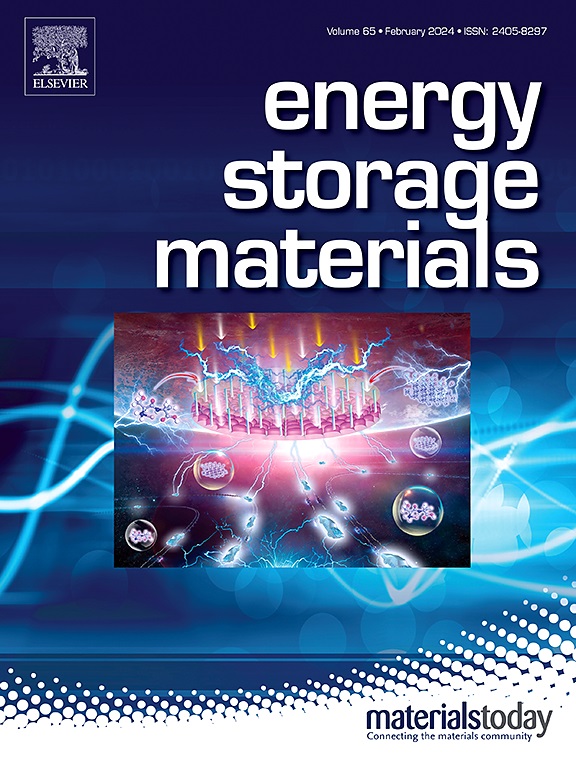k离子电池用聚阴离子基正极材料
IF 20.2
1区 材料科学
Q1 CHEMISTRY, PHYSICAL
引用次数: 0
摘要
除了锂离子电池(lib)之外,对可持续能源存储解决方案的迫切需求将k离子电池(kib)推向了聚光灯下,利用钾的地壳丰度、成本效益和有利的离子迁移率。这篇综述批判性地研究了聚阴离子阴极材料在解决K+离子带来的独特挑战方面的变革潜力,特别是它们的大离子半径(1.38 Å)和结构相容性,同时利用它们的高压操作和强大的循环稳定性。我们阐明了聚阴离子框架(如磷酸盐、氟磷酸盐、硫酸盐和焦磷酸盐)的结构和电化学优点,强调了它们通过强共价X - o键(X = P, S, F)产生的感应效应稳定高压操作(>4.0 V vs. K/K+)的能力。关键材料家族,包括nasiconon型K3V2(PO4)3,氟硫酸盐(KFeSO4F)和混合聚阴离子体系(K4Fe3(PO4)2P2O7),系统地分析了结构-性能-性能关系。溶胶-凝胶处理、水热模板和电化学离子交换等先进的合成策略在优化离子/电子电导率和减轻界面不稳定性方面发挥了重要作用。尽管取得了进展,但在平衡能量密度(基于阴极质量计算的400 Wh kg-1)和可循环性(1000次循环)方面仍然存在挑战,需要纳米级工程、阴离子/阳离子共掺杂和导电矩阵集成等协同策略。该综述强调了钛基和锰基聚阴离子、亚稳氟磷酸盐衍生物和克服动力学限制的分层结构尚未开发的潜力。通过将基本见解与可扩展的制造考虑相结合,这项工作为将kib推进到电网规模的存储和电气化运输提供了路线图,绕过了锂的地缘政治限制,同时开辟了高能量、可持续电化学的新领域。本文章由计算机程序翻译,如有差异,请以英文原文为准。


Polyanionic-based cathode materials for K-ion batteries
The urgent need for sustainable energy storage solutions beyond lithium-ion batteries (LIBs) has propelled K-ion batteries (KIBs) into the spotlight, leveraging potassium’s crustal abundance, cost-effectiveness, and favorable ionic mobility. This review critically examines the transformative potential of polyanionic cathode materials in addressing the unique challenges posed by K+ ions notably their large ionic radius (1.38 Å) and structural compatibility while capitalizing on their high-voltage operation and robust cycling stability. We elucidate the structural and electrochemical merits of polyanionic frameworks (e.g., phosphate, fluorophosphate, sulfates, and pyrophosphate), emphasizing their capacity to stabilize high-voltage operation (>4.0 V vs. K/K+) through inductive effects enabled by strong covalent X–O bonds (X = P, S, F). Key material families, including NASICON-type K3V2(PO4)3, fluorosulfate (KFeSO4F), and mixed polyanion systems (K4Fe3(PO4)2P2O7), are systematically analyzed to unravel structure-property-performance relationships. Advanced synthesis strategies such as sol-gel processing, hydrothermal templating, and electrochemical ion exchange are highlighted for their role in optimizing ionic/electronic conductivity and mitigating interfacial instability. Despite progress, challenges persist in balancing energy density (>400 Wh kg-1 calculated based on the cathode mass) with cyclability (>1000 cycles), necessitating synergistic strategies like nanoscale engineering, anion/cation co-doping, and conductive matrix integration. The review underscores the untapped potential of titanium- and manganese-based polyanionics, metastable fluorophosphate derivatives, and hierarchical architectures to overcome kinetic limitations. By bridging fundamental insights with scalable manufacturing considerations, this work provides a roadmap for advancing KIBs toward grid-scale storage and electrified transportation, circumventing lithium’s geopolitical constraints while unlocking new frontiers in high-energy, sustainable electrochemistry.
求助全文
通过发布文献求助,成功后即可免费获取论文全文。
去求助
来源期刊

Energy Storage Materials
Materials Science-General Materials Science
CiteScore
33.00
自引率
5.90%
发文量
652
审稿时长
27 days
期刊介绍:
Energy Storage Materials is a global interdisciplinary journal dedicated to sharing scientific and technological advancements in materials and devices for advanced energy storage and related energy conversion, such as in metal-O2 batteries. The journal features comprehensive research articles, including full papers and short communications, as well as authoritative feature articles and reviews by leading experts in the field.
Energy Storage Materials covers a wide range of topics, including the synthesis, fabrication, structure, properties, performance, and technological applications of energy storage materials. Additionally, the journal explores strategies, policies, and developments in the field of energy storage materials and devices for sustainable energy.
Published papers are selected based on their scientific and technological significance, their ability to provide valuable new knowledge, and their relevance to the international research community.
 求助内容:
求助内容: 应助结果提醒方式:
应助结果提醒方式:


